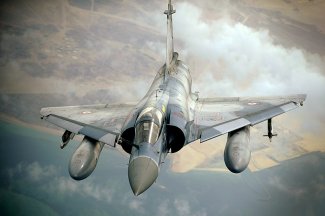France sends Mirage 2000-5 fighters for Ukraine. Day 838 of the war

![]()
Russian troops are continuing to advance in several directions in a wide arc west of Donetsk. Their actions indicate that they intend to cut the Pokrovsk-Kostiantynivka route, which is the main line of communication linking Ukrainian forces in the west and north of Donetsk oblast. After entering Novooleksandrivka, the Russians found themselves less than 8 km from this route; that makes it more likely that they will shell it, thus making it difficult for Ukraine to move units and supplies between the main defence areas. The invaders’ forces are advancing along the M04 highway from Donetsk to Dnipro city, having seized the village of Netaylove and started fighting for Karlivka. In turn, the defenders’ expulsion from Paraskoviyvka has enabled them to proceed with the assault on Kostiantynivka, a nodal village on the Vuhledar-Mariinka route. Virtually the entire southern part of the town of Krasnohorivka has now come under Russian control.
Under pressure from the invaders and the threat of being outflanked from the north, Ukrainian forces withdrew from parts of the so-called Kanal microdistrict in the town of Chasiv Yar. Russian units also launched attacks on the Novy microdistrict on the western side of the Donets-Donbas canal, although they failed to capture the bridgehead. The Russians also re-occupied Staromayorske south of Velyka Novosilka, the recapture of which marked the peak of last year’s Ukrainian offensive in the western part of Donetsk oblast.
Russian forces have effectively gone on the defensive along most of the newly created section of the front in Kharkiv oblast. Vovchansk is still the main combat zone; the Ukrainians are still maintaining a bridgehead in the northern part of the town. The Ukrainian side has given contradictory reports about the situation in Kherson oblast, where the defenders have probably been withdrawn from their bridgeheads on the left bank of the Dnieper, including at the town of Krynki. The units operating there have been redeployed to the frontline in the Kharkiv region.
The Russian advances observed in recent weeks are a direct consequence of the redeployment of some Ukrainian forces from their previous lines of operation to the Kharkiv area. However, the need to disperse the effort has been partly compensated for by intensified deliveries of arms and ammunition (mainly from the US), which have allowed the defenders to regain relative freedom of artillery fire along the sections which are most threatened. There is also still no sign that the invaders are forming offensive groupings along any of the axes of attack which could exploit the tactical successes they have achieved on an operational scale.
![]()
The intensity of Russian missile attacks whose main targets are the defenders’ direct hinterland and the main military airfields has decreased. Ukrainian air force bases in Myrhorod in Poltava oblast (7, 9 and 10 June) and Starokostiantyniv in Khmelnytsky oblast (6 and 7 June) were attacked several times, as were the military facilities in Odesa oblast from where Ukrainian attacks on Crimea are primarily being launched (5, 6 and 7 June). The only strike on critical infrastructure, including in Kyiv oblast, took place on 7 June, wherein the Russians mainly used kamikaze drones. According to Kyiv, from the evening of 4 June to the morning of 11 June the Russians used 24 missiles, six of which were shot down, as well as 111 Shaheds (including 53 on 7 June), 96 of which were destroyed.
![]()
Ukrainian missiles and drones struck Russian military installations in Crimea several times. On 10 June they targeted air defence squadrons in the area of Dzhankoy (with S-400 systems), Chornomorskiy and Yevpatoria (with S-300 systems). Satellite imagery confirmed damage to what was probably one component of the S-400 system. The attack of 8 June did not have any significant effect, while according to Ukrainian military intelligence (HUR), a project-498 harbour tug (either the Saturn or the Protey) was destroyed in the 6 June attack, but this has not been confirmed by other sources. On 6 June there were further strikes on Russian fuel infrastructure. Fires broke out at a refinery in Novoshakhtinsk in Rostov oblast (which had already been attacked in March and April) and at a fuel depot in Belgorod oblast. Ukrainian drones attacked the Russian Defence Ministry’s flight test centre in Akhtyubinsk on 8 June, where a prototype of a fifth-generation Su-57 multi-role combat aircraft was damaged by shrapnel. Satellite imagery also indicates that a second aircraft of this type may have been slightly damaged. This is the first incident of the latest Russian military aircraft being struck.
On 5 June, Ukrainian military intelligence revealed that it had launched a large-scale DDoS attack on Russian government agencies, banks and news portals. Access to the websites of the ministries of defence, finance, the interior, justice and the tax service, among others, was restricted for several days. The Sbierbank and Alfabank banks were also targeted, and there were also disruptions to the social networking site vKontakte. An official communiqué issued by Russia’s Roskomnadzor agency stated that the disruptions, which began on 3 June, were due to “a fundamental malfunction of the communication network”.
![]()
On 7 June, HUR warned that Russian special services were preparing another information and psychological operation in the media space of Ukraine and Western countries to discredit the military, including those serving in HUR. $15 million has been allocated for this purpose. It is planned to reveal data from HUR personnel who have been involved in coordinating the activities of special units.
![]()
On 6 June, President Emmanuel Macron announced that his government would hand over several Mirage 2000-5 fighters to Ukraine and create a 4500-strong Ukrainian ‘French brigade’, to be trained and equipped by France. The training of the Ukrainian pilots would begin in the summer and last five to six months, with deliveries of the aircraft to begin by the end of the year. French media have speculated that at least initially, of the 26 planes still in service with the French air force Kyiv could receive between six and 12, the latter if other users get involved (such as Qatar, Greece or the United Arab Emirates) or if the President puts pressure on the defence ministry to deviate from the rearmament schedule currently in force.
Right after Macron's announcement the Ukrainian air command, which had previously repeatedly spoken negatively about the possibility of acquiring the Mirage 2000, once again presented a list of aircraft and supplies it would ultimately like to acquire – but the fighter being offered by France is not among them.
Fulfilling Macron’s promise, while potentially strengthening the Ukrainian army, could in the near term create major new problems for its operation. The likely number of aircraft transferred would be too small to have a real impact on combat operations. The Mirage 2000 is also a distinctly different design from the F-16, which Ukraine is expected to start acquiring in the near future, and for which Ukrainian pilots and ground crew are being prepared. Ukraine does not have enough pilots to use all the F-16s potentially available to it (training new ones will take several years), and the maintenance situation is even more difficult. The variety of types of equipment is already causing problems for the Ukrainian army, which it cannot solve even with full support from the West (and what help there is is insufficient).
The situation is similar in the case of the ‘French brigade’, the relatively rapid creation of which would require the drain of already existing Ukrainian army units of officer and NCO cadres, whose training also takes several years (compared to several months for a private soldier). The only solution to these problems which would enable the use of French fighters and the ‘French brigade’ would be the secondment of volunteer or mercenary cadres from other countries (in the case of a brigade whose members spoke Ukrainian or Russian).
On 7 June, Washington announced another military support package worth $225 million under the Presidential Drawdown Authority (PDA) mechanism. This will include anti-aircraft missiles for the Hawk and Stinger systems, missiles for the HIMARS launcher, at least two 155-mm towed howitzers and 155-mm and 105-mm artillery ammunition, Javelin and TOW anti-tank guided missiles and AT-4 grenade launchers, around 200 M113 tracked transporters, and coastal & river patrol boats.
Rheinmetall and the Ukrainian Defence Industries company have launched the first workshop for the ‘overhaul and production of armoured weapons’, Ukroboronprom reported on 10 June. Military vehicles donated to the Ukrainian army by Germany, including Marder infantry fighting vehicles, are to be overhauled and serviced there. Heavier armaments (mainly Leopard tanks) will continue to be repaired outside Ukraine, including in Poland. No information is available as to whether Rheinmetall’s employees will be involved in the project, in the same way that the companies of the Polish Armaments Group (PGZ) operating in Ukraine have been doing for the past two years, dealing with the servicing and ongoing repair of weaponry donated by Poland.
On 11 June, the US State Department announced that the US had lifted its ban on the supply of arms to the 12th Azov Special Forces Brigade of the Ukrainian National Guard. The previous restrictions stemmed from a ban on US military aid to foreign military units known to have committed serious human rights violations. In a statement, the State Department said it had “found no evidence” of such violations; in 2014, US officials indicated that some of the regiment’s organisers had expressed racist, xenophobic and ultranationalist views.
![]()
On 6 June the Ukrainian defence ministry reported that 1,412,000 men had registered for military commissions using the Reserve+ application, including more than 18,000 Ukrainians residing abroad (mainly in Poland, the Czech Republic, Canada and the US).
On 7 June the Ukrainian government issued a decree allowing companies to exclude all their employees from military appointments for one year. This applies to defence industry establishments which are carrying out contracts for the Armed Forces, energy companies, the coal industry, oil & gas companies, and those restoring or repairing damaged energy infrastructure and building fortifications. The government’s decision came in response to growing criticism from managers of strategic companies, who pointed out that calling up even some of the skilled workers would have a negative impact on the efficiency of the plants.
On the same day, Ukraine’s interior minister Ihor Klymenko announced that 90% of police officers and employees of the State Emergency Service (including firefighters) would not be subject to mobilisation. The remaining 10% will be able to join one of the four assault brigades of the National Police.
On 9 June, Ukrainian border service spokesman Andriy Demchenko said that there had been no sharp increase in attempts by men of conscription age to illegally cross the border after the mobilisation legislation came into force. He added, however, that such attempts are recorded on a daily basis, and for a long time most such fugitives have been stopped at the borders with Romania and Moldova.
![]()
On 10 June, Minsk announced that the Belarusian army would participate in the second stage of Russian exercises concerning the use of tactical nuclear weapons. The first stage took place in May in the Russian Armed Forces’ Southern Military District. During the exercises in southern Russia, satellite images appeared confirming that the infrastructure of the Belarusian base in Asipovichy had been expanded, increasing its capacity to host additional squadrons of the Iskander system. According to some assessments, two units – the Belarussian 465th Missile Brigade, and either a Russian brigade or a newly formed brigade of the Belarusian army – could eventually be stationed there.
![]()
On 4 June the parliament of Ukraine, taking a proposal from the president into account, dropped a law allowing an employer to dismiss an employee for failing to report relations with persons residing in the Russian Federation and the occupied territories. The change of position followed a protest by eight human rights organisations in Ukraine, which indicated that the new provision would be “grounds for the harassment and stigmatisation of people who have relatives residing in Russia or the occupied territories”.






